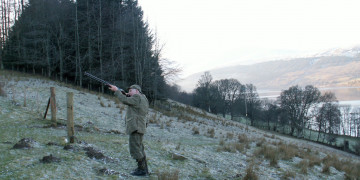Scottish Rivers Beckon: The 2024 Salmon Fishing Season Begins

Scotland’s 2024 salmon fishing season is off to an exciting start, with opening days on several iconic rivers already underway or soon approaching. The start of the season brings a sense of optimism among anglers, with hope of spring salmon on some of Scotland’s most storied waters.
As February opens, seasoned fishers eagerly prepare alongside novices stepping into waders for the first time. Tackle boxes brim with meticulously tied flies, reels are loaded with fresh lines, and rods are rigged with a palpable air of anticipation. Scotland’s wild rivers and lochs beckon, ready to challenge anglers and potentially yield trophy catches.
The River Tay opened on 15th January and the Dee and Tweed on the 1st of February, as tradition dictates.
And on the 12th, the mighty Spey opened. Each river promises its personality and charm, allowing fishers to try various techniques across unique landscapes.
Photo courtesy of VisitScotland / Paul Tomkins
Popular Scottish Rivers for Salmon Fishing
River Dee
Winding regally through Aberdeenshire on its way to the North Sea, the River Dee holds a special place in Scottish salmon fishing lore. The Dee boasts the distinction of being one of the most famous salmon rivers in the world while offering anglers a spectacular backdrop.
From its source high in the Cairngorms, the Dee flows through the heart of Deeside before reaching the North Sea at the port of Aberdeen. The river supports healthy salmon and sea trout populations, brown trout, grayling, and pike.
The Dee’s most productive stretch flows through woodlands and fertile wildlife-rich farmland. A day spent fishing these waters with a renowned Gillie promises enjoyment whether or not fish are caught. But landing a salmon from the Dee’s riffles and pools certainly creates memories to last a lifetime.
Photo courtesy of VisitScotland / Paul Tomkins
River Spey
The “Silver River” Spey offers a world-renowned experience for salmon anglers each season. Stretching over 100 miles from its source on the Monadhliath mountains to the Moray Firth, the Spey provides extensive opportunities for fishers to test various pools and tributaries.
The Spey hosts runs of spring salmon starting in February and continuing into late summer. By June, summer salmon start ascending the river, much to the delight of hopeful casters. These months bring sizzling action, with the deep pools presenting chances for battling mighty salmon.
A Speyside stay in a quaint lodge along the riverbanks, paired with a day’s guided fishing, makes for an unforgettable outing.
Photo courtesy of VisitScotland / Paul Tomkins
River Tay
As Scotland’s longest river, the mighty Tay offers plentiful salmon fishing along its epic expanse. Flowing over 120 miles from the Highlands through Perthshire and Central Scotland, the Tay boasts a variety of salmon fishing opportunities along the 50 mile leg of Tay.
The River Tay transforms into its final 50-mile tidal stretch at Perth, beginning from Loch Tay’s exit at Kenmore. It gains momentum with the addition of the River Lyon near Aberfeldy, attracting salmon anglers along its 18-mile Kenmore to Ballinluig stretch. The confluence with the River Tummel marks the start of the “middle” Tay, where the river widens and requires boats for salmon fishing across its 19-mile expanse. Further downstream, the Tay deepens and flows through a sandstone gorge, offering stunning landscapes and premier salmon fishing spots. As it nears Perth, the river broadens before meeting its last significant tributary, the River Almond, at Scone Palace, where it becomes tidal.
On the storied waters of the River Tay, a fishing legend was born in 1922. Georgina Ballantine’s name would forever be etched into angling history when, accompanied by her father James Ballantine, she reeled in a colossal salmon on October 7th. Weighing in at 64 lbs and measuring 54 inches long, this record-breaking catch remains unchallenged in the UK, a testament to Georgina’s skill and determination.
A day spent fishing the Tay and its feeder waters promises majesty whether or not fish come to the net. But a silvery Tay salmon adds icing on the cake for a trip to remember always.
Photo courtesy of VisitScotland / Kenny Lam
River Tweed
Known globally as one of Scotland’s elite salmon fishing rivers, the famous River Tweed possesses an undeniable pedigree and charm. Flowing eastward along the border region with England through the picturesque valley bearing its name, the Tweed’s lyrical beauty endears itself to fishers uniquely.
Born in the Lowther Hills north of Moffat, in the Scottish Borders, the River Tweed meanders 95 miles through spectacular scenery passing through historic towns such as Peebles, Galashiels, Selkirk, Kelso and Berwick upon Tweed. Locals speak of the “Tweed personality” – an essence capturing the river’s soul and the unquantifiable tug it forever exerts on those who experience her waters.
In addition to the mighty Tweed, there are several notable tributaries that enrich its waters. Among them are the Till, Teviot, and Ettrick rivers. These tributaries boast remarkable productivity, yielding robust salmon and sizable sea trout, particularly when water levels are favourable.
For Salmon fishers, the Tweed is famous for its abundant autumn salmon run, offering excellent fishing opportunities from late August to November’s end. Anglers worldwide flock to its waters during this season, making it a top destination for salmon fishing in Scotland.
Regulations and Conservation Efforts
To protect Scotland’s vulnerable salmon populations, fisheries managers continue implementing careful regulations and conservation initiatives designed to ensure the sustainability of these fisheries for future generations. Ongoing monitoring helps assess stocks and adapt guidelines appropriately from season to season.
Strict catch limits now apply across Scottish salmon rivers, with most anglers required to practice mandatory catch-and-release fishing.
You can view the guidelines and conservation policy here:
River Tweed: https://rivertweed.org.uk/fishing/tweed-angling-codes/
River Tay: https://tayrivers.org/angling/
River Spey: https://riverspey.org/fishing/angling-guidelines
River Dee: https://riverdee.org.uk/dee-conservation-code/
Innovative programs sponsored by bodies like the Atlantic Salmon Trust also aid conservation efforts through activities like monitoring smolt runs and supporting projects to improve habitat and water quality. Scotland’s salmon rivers hold global iconic status as coveted fisheries, making maintaining their health vital both environmentally and economically.
Find out more: https://atlanticsalmontrust.org/
Techniques and Equipment
Various effective techniques and equipment help Scottish salmon fishers maximise their chances each season. Most anglers practice fly fishing, using weighted flies like tubes, brass bodies, or cast lead heads to achieve depth and ignite strikes in heavy water.
Regarding fly selection, standards like the Willie Gunn, Ally’s Shrimp, or Sunray Shadow variants always deserve a place in the box. But locals swear by their treasured home-brewed patterns passed through generations on these storied rivers. It can also depend on the time of year and the water condition.
Rods and reels capable of managing heart-stopping fights with tenacious Scottish salmon are essential. For fishing on big rivers, you need big tackle for example a 14ft – 15ft double hand Spey fly rod will help not only with the big fish but also the size of river. Many local ghillies meticulously handcrafted rods specifically suited to the home waters they know so intimately. Hardy, Loop, or Scierra reels offer silky drags, ensuring hard runners make it to hand. Waders, polarised glasses, sharpened hooks, and perseverance round out the kit for wrestling salmon from Scotland’s spring runs.
Photo courtesy of VisitScotland / Kenny Lam
Impact of Weather and Environment
As spring takes hold across the Scottish landscape, all eyes turn towards the skies and hills that shape the kingdom’s salmon rivers and lochs. Weather and environmental factors wield enormous influence in determining the success of each season’s returning runs timing and strength.
Following a relatively mild winter, fisheries scientists predict elevated water temperatures if drought conditions persist into spring. Warmer flows could prompt salmon to run early before rain and meltwater cool the rivers. This scenario might compact the spring season into a shorter, more intense period of heightened fishing.
Climatologists also note long-term warming and water loss from climate change effects may continue decreasing Scotland’s salmon populations in vulnerable rivers. Maintaining suitably habitable conditions and connectivity in tributary spawning grounds remains a key conservation focus to counter declining runs.
Photo courtesy of VisitScotland / Kenny Lam






























0 Comments